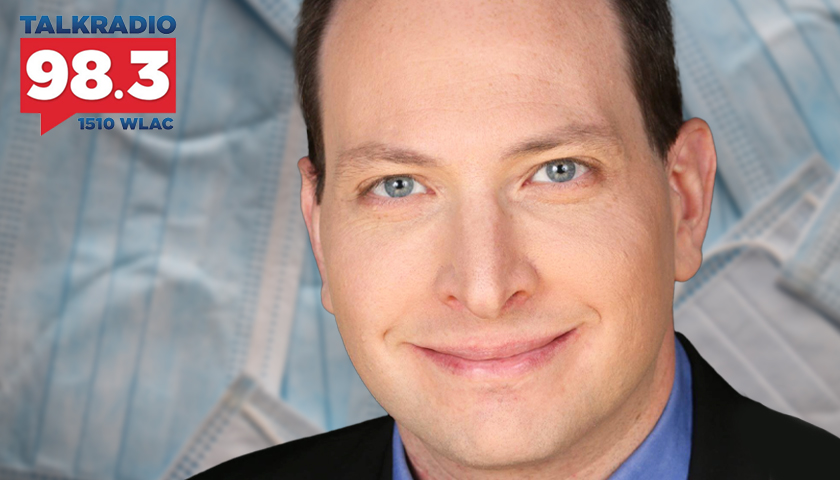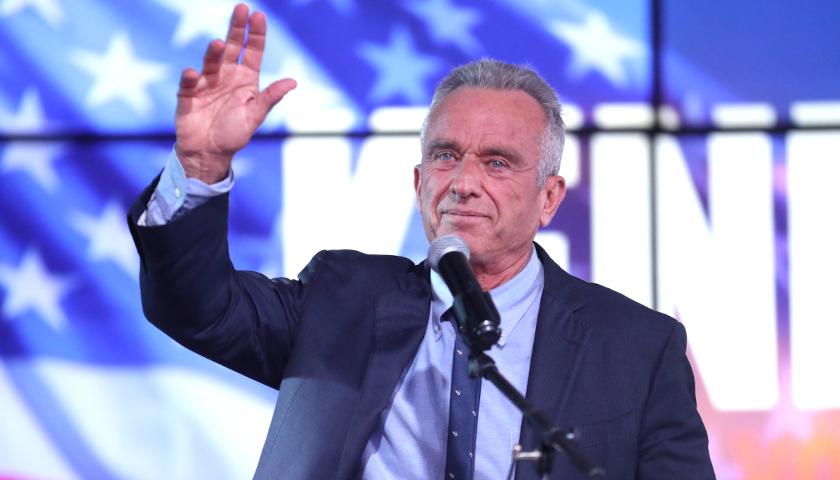Live from Music Row Friday morning on The Tennessee Star Report with Michael Patrick Leahy – broadcast on Nashville’s Talk Radio 98.3 and 1510 WLAC weekdays from 5:00 a.m. to 8:00 a.m. – host Leahy welcomed American Commitment’s President Phil Kerpen to the newsmaker who explained the data of why masks do not make sense for children in the reduction of COVID transmission.
Leahy: And we welcome to our newsmaker line, my very good friend for many years, Phil Kerpen, the president of American Commitment. Good morning, Phil.
Kerpen: Hey, good morning. Great to be with you.
Leahy: Phil, we’ve known each other before the Tea Party days back in 2008, 2009. And I was delighted to see that you have really focused on the science of masks and their efficacy in limiting the transmission of COVID-19. Now I’ve looked at the science on this, and I can’t see that they have any effect. What have you found?
Kerpen: Pretty close to zero. Yes. They’ve got two kinds of studies that they rely on to claim that masks work. One of these ecological studies, which is when you compare different areas. And they did this with counties in Kansas.
And they did a version in Arizona. And they kind of pick the peak of the curve when masks were put in. And then they say, see, look, masks were put in here and cases went down.
And if you choose different dates, you get totally opposite results. And so those studies are essentially useless. And then the other thing they have are these mechanistic studies, which is basically when they’re messing around with mannequins in labs and they put the very tight mask on the mannequin.
Then they measure that not as much as coming out is when you don’t have the mask on. And then they say, see, it reduces particles by whatever percentage. That would be fine if people were mannequins, but they’re not. (Leahy laughs)
And so that’s basically what they have. And then you kind of look at the other side of the so the higher-quality studies, the randomized control trials. And we’ve got about a dozen of these over the years for respiratory viruses, and there’s a null effect.
There’s no detectable effect. And I tend to go with the higher quality studies over the lower quality ones. And I think that it’s consistent with what we’ve seen. They made all these promises. They said you all will put on the mask, the virus will be gone in a few weeks.
There’s no detectable effect anywhere that this was done. And I think and I fear an idealized lab condition and somebody’s wearing it when it’s perfectly sealed around the nose and around the sides, you would get some reduction.
It wouldn’t be huge, but you would get some reduction. In the real world, the way people actually wear them I think the respiratory aerosols go right over the top or right out the sides.
And then you sort of think, let’s say you are wearing it exactly the way they say you are and you increase the exposure time for a transmission event from 15 minutes to 20 minutes or 22 minutes or whatever.
Just in practice, people are still going to be exposed. It’s just not going to make much difference any way you look at it. And then the other piece of this is I’m pretty sure everyone who hasn’t been exposed to this virus will be.
It’s a highly infectious respiratory virus. It’s not going away anytime soon. The vaccines are pretty good at reducing hospitalization and death, but they’re not really reducing transmission that much. So they’re not going to prevent people from being exposed.
Everyone’s going to be exposed to this. You’re not going to prevent it no matter what efforts society or the government or whatever puts in. So we’re doing these extraordinarily disruptive things, and there’s just nothing to show for it benefit to show for it.
Leahy: Phil, our all-star panelist Crom Carmichael has a question for you.
Carmichael: Hey Phil. Have you seen any studies on the effects of masks on young children? Kindergarten, 1st grade, 2nd grade? In other words, children between age say, four and eight.
Kerpen: Yes. We’re really one of the only places in the world that are masking young children. So we’re an extreme outlier on this. There are basically three other countries that go down to age six.
That’s France, Spain, and Italy. But most of Europe has never masked under age twelve. And a lot of Europe has never masked any children at all. And the U.S. has this weird recommendation from age two.
There’s no benefit in terms of transmission or avoided cases that we can see in the data among young children. And that really shouldn’t be particularly surprising. Even if maths worked, that’s the age group that’s least likely to get a benefit from it for two reasons.
One is that they have a very low disease burden with COVID and very low transmission. But the second is they’re the least likely to have a very tight-fitting task around the nose and then around the sides where nothing’s coming out.
Just in practice, you’re not going to see any benefit. What you do see, though, is the enormous harms associated with masking young children which is why many countries never did it. And in particular, there is an enormous impact on language and communication development.
There’s an enormous negative educational impact on children not being able to see mouths and faces and to associate sounds with mouth movements. And that’s why most educational experts in most countries were totally opposed to it and it never happened in most places.
In the U.S. for whatever reason, we ignored that fact. And in addition to the educational harms, you’ve got a lot of health harms, both mental health harms and anxiety. And we’ve got a mental health crisis among small children as a consequence of doing this.
And physical health harms, you’ve got a lot of children saying they experience headaches and who have discomfort. There are a lot of issues associated with them. So I think there are just enormous enormous negative consequences associated with masking young children.
And we really don’t see any benefit in terms of stopping COVID transmission. Remember that for children, it’s a very normal virus.
And what I mean by that is the risk of COVID for a child is really no different than any other respiratory virus, any other cold, or flu. It’s not a disproportionate risk the way it is for old people. It’s a very normal risk.
And really the way they justified trying to put restrictions on children last year, is they said well, they could give it to a grandparent or they could give it to a high-risk person. And that was always rare because children rarely infect adults.
Now all of those adults have the opportunity to get the vaccine if they want to. And I just don’t see how we can continue to put impositions on children to try to prevent those types of hypotheticals when the children themselves are harmed by it.
So I don’t think it would have been ethical even if it did work, but it didn’t work. And we’ve got pretty clear data now than the school context, not just for the smaller children, but even for the older children.
The case rates are no lower in schools that mask kids than in schools that don’t. And in fact, in the data of the case rates seem to be a little bit higher in the mask mandatory schools than in the mask optional schools. It’s not an effective intervention, and it does produce considerable harms.
Leahy: Phil Kerpen, president of American Commitment. There are two people that I can think of that have really gone and looked at the data at a national level and have really taken the bull by the horns shall we say, pointing out the false nature of all of the ‘science claims’ put out by the national federal government and the left.
Alex Berenson, a former New York Times reporter, and you. Now my question is, Phil, what prompted you to focus on this and just do this very deep dive on the evidence?
Kerpen: Well, I normally work on economic policy, as you know, but it’s hard to care much about the normal soft taxes and spending and regulation when you’ve got the government shutting down businesses and forcing children to cover their faces for eight hours at a time.
And the extremism of the interventions that have been imposed has made it more urgent than the usual issues that I work on. And, of course, I’ve got four young children myself. It’s pretty personal, the stuff that kids are being put through. So I think that motivates me as well.
Leahy: That’s what I thought. I thought it was the four kids. Now tell me, are your kids in school right now?
Kerpen: They haven’t started the new school year yet. We’re a week away here, so not yet. But they had a pretty rough school year last year. They’re in a Catholic school in D.C. We are actually switching schools this year because of how bad it was last year.
But you know how political all this is. As bad as it is where you are, D.C. is probably about five notches more liberal than Nashville. It’s like, around the bend crazy left-wing. And so we were one of these places where the public schools were closed pretty much the whole year.
And the Catholic schools were two days a week. And they wanted you to thank them for being so lovely and wonderful and giving you two of the five days you were paying for. (Leahy laughs) And the two days they were there was like a prison school, and it wasn’t good.
Leahy: Well, Phil Kerpan, thanks so much for really your dedication to finding the truth on this. I for one really appreciate you’re doing that. Thanks for joining us, Phil.
Kerpen: All right. Have a good one, guys.
– – –
Tune in weekdays from 5:00 – 8:00 a.m. to the Tennessee Star Report with Michael Patrick Leahy on Talk Radio 98.3 FM WLAC 1510. Listen online at iHeart Radio. author bio
Photo “Phil Kerpen” by Phil Kerpen.





